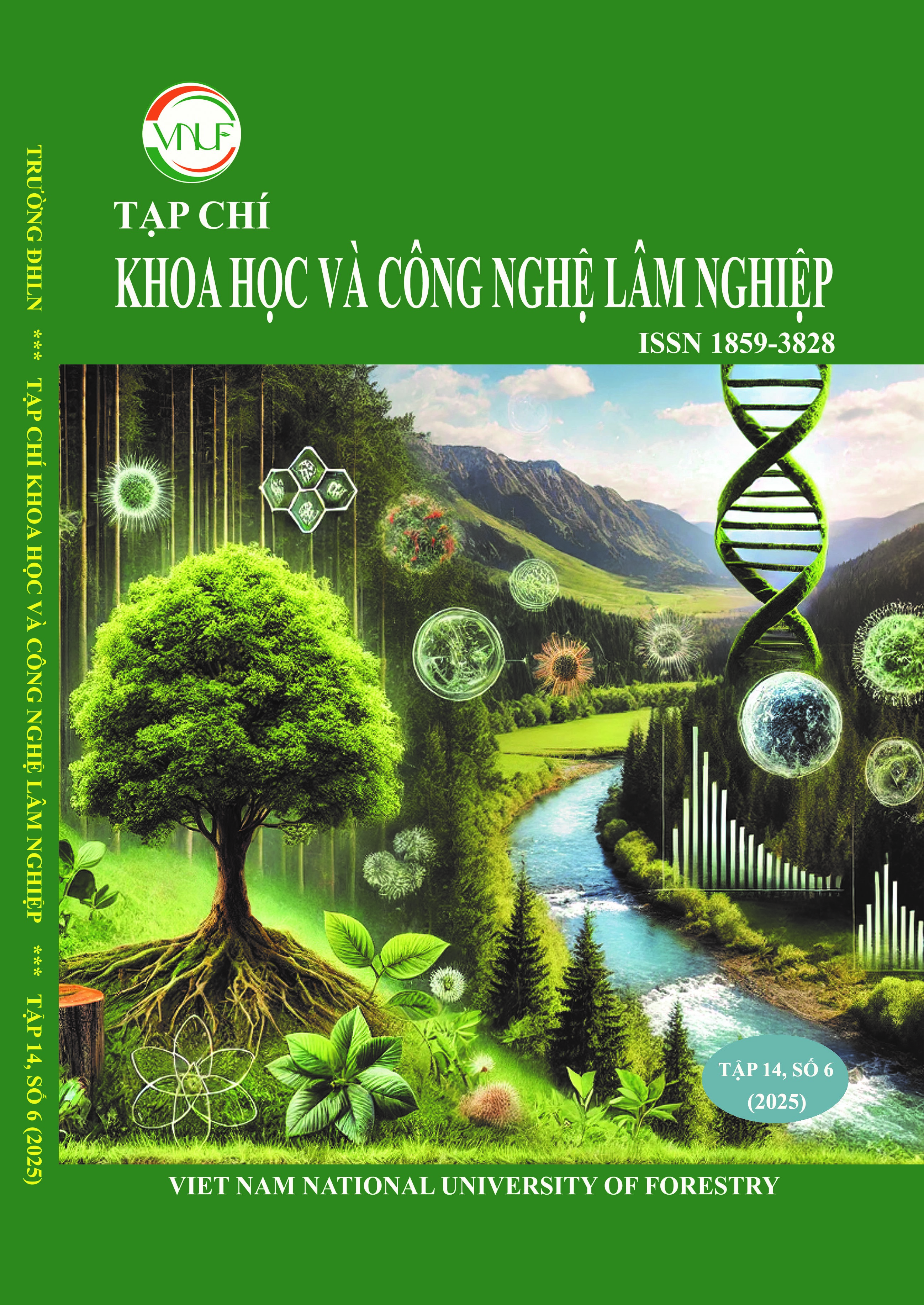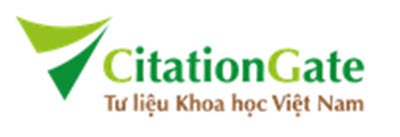Khảo sát hoạt tính kháng oxy hóa và ức chế tyrosinase của Gừng xoài (Curcuma amada Roxb.)
DOI:
https://doi.org/10.55250/Jo.vnuf.14.6.2025.030-037Từ khóa:
Curcuma amada, ethyl acetate, kháng ôxy hóa, ức chế enzyme tyrosinaseTóm tắt
Chiết xuất từ thực vật từ lâu đã được xem là phương thuốc quan trọng giúp duy trì sức khỏe, tăng cường miễn dịch và phòng ngừa, điều trị bệnh mạn tính. Các hợp chất tự nhiên có trong thảo mộc, gia vị, trái cây và rau củ không chỉ tạo hương vị cho thực phẩm mà còn mang lại nhiều lợi ích sức khỏe. Các thành phần hoạt tính như polyphenol, terpenoid, alkaloid và flavonoid trong thực vật đã chứng minh cơ sở khoa học cho việc sử dụng rộng rãi của chúng trong y học và dinh dưỡng. Gừng xoài (Curcuma amada Roxb.) là một loại gia vị có giá trị được ứng dụng rộng rãi trong ẩm thực và y học cổ truyền. Nghiên cứu này tiến hành so sánh các loại chiết xuất từ rễ củ C. amada dạng tươi và khô bằng các dung môi khác nhau nhằm đánh giá khả năng chống oxy hóa và ức chế enzyme tyrosinase. Kết quả cho thấy chiết xuất ethyl acetate từ mẫu tươi thể hiện hoạt tính mạnh nhất, với giá trị IC₅₀ đối với DPPH và ABTS lần lượt là 8,3 ± 0,007 µg/mL và 4,9 ± 0,87 µg/mL. Đồng thời, chiết xuất này cũng cho thấy khả năng ức chế enzyme tyrosinase hiệu quả nhất (IC₅₀ = 42,64 ± 0,41 µg/mL), vượt trội so với các chiết xuất từ acetone, methanol, ethanol và nước. Ngoài ra, mẫu tươi nhìn chung cho hoạt tính sinh học cao hơn mẫu khô, cho thấy tiềm năng sử dụng nguyên liệu tươi trong các ứng dụng chống oxy hóa và ức chế tyrosinase.
Tài liệu tham khảo
[1]. Naima Saeed, Muhammad R Khan & Maria Shabbir (2012). Antioxidant activity, total phenolic and total flavonoid contents of whole plant extracts Torilis leptophylla L. BMC complementary and alternative medicine. 12(1): 221.
[2]. Marian Naczk & Fereidoon Shahidi (2004). Extraction and analysis of phenolics in food. Journal of chromatography A. 1054(1-2): 95-111.
[3]. Sibel Karakaya (2004). Bioavailability of phenolic compounds. Critical reviews in food science and nutrition. 44(6): 453-464.
[4]. CELIA JIMENEZ‐CERVANTES, Paloma Valverde, JOSÉ C GARCÍA‐BORRÓN, Francisco Solano & Jose A Lozano (1993). Improved tyrosinase activity stains in polyacrylamide electrophoresis gels. Pigment cell research. 6(6): 394-399.
[5]. Sailendra Singh, Jonnala Kotesh Kumar, Dharmendra Saikia, Karuna Shanker, Jay Prakash Thakur, Arvind Singh Negi & Suchitra Banerjee (2010). A bioactive labdane diterpenoid from Curcuma amada and its semisynthetic analogues as antitubercular agents. European journal of medicinal chemistry. 45(9): 4379-4382.
[6]. Shakeel Ahmad Jatoi, Akira Kikuchi, Syed Abdullah Gilani & Kazuo N Watanabe (2007). Phytochemical, pharmacological and ethnobotanical studies in mango ginger (Curcuma amada Roxb.; Zingiberaceae). Phytotherapy Research: An International Journal Devoted to Pharmacological and Toxicological Evaluation of Natural Product Derivatives. 21(6): 507-516.
[7]. RS Policegoudra, K Rehna, L Jaganmohan Rao & SM Aradhya (2010). Antimicrobial, antioxidant, cytotoxicity and platelet aggregation inhibitory activity of a novel molecule isolated and characterized from mango ginger (Curcuma amada Roxb.) rhizome. Journal of biosciences. 35(2): 231-240.
[8]. RS Policegoudra, K Abiraj, D Channe Gowda & SM Aradhya (2007). Isolation and characterization of antioxidant and antibacterial compound from mango ginger (Curcuma amada Roxb.) rhizome. Journal of Chromatography B. 852(1-2): 40-48.
[9]. Patricio J Cáceres, Cristina Martínez-Villaluenga, Lourdes Amigo & Juana Frias (2014). Maximising the phytochemical content and antioxidant activity of Ecuadorian brown rice sprouts through optimal germination conditions. Food chemistry. 152: 407-414.
[10]. A Djeridane, M Yousfi, B Nadjemi, D Boutassouna, P Stocker & N Vidal (2006). Antioxidant activity of some Algerian medicinal plants extracts containing phenolic compounds. Food chemistry. 97(4): 654-660.
[11]. George Boskou (2010). Antioxidant capacity and phenolic profile of table olives from the Greek market. Olives and olive oil in health and disease prevention. Elsevier. 925-934.
[12]. Roberta Re, Nicoletta Pellegrini, Anna Proteggente, Ananth Pannala, Min Yang & Catherine Rice-Evans (1999). Antioxidant activity applying an improved ABTS radical cation decolorization assay. Free radical biology and medicine. 26(9-10): 1231-1237.
[13]. Sarin Tadtong, Amornrat Viriyaroj, Suwanna Vorarat, Sathaporn Nimkulrat & Sunit Suksamrarn (2009). Antityrosinase and antibacterial activities of mangosteen pericarp extract. J Health Res. 23(2): 99-102.
[14]. Yolanda Aguilera, Isabel Estrella, Vanesa Benitez, Rosa M Esteban & María A Martín-Cabrejas (2011). Bioactive phenolic compounds and functional properties of dehydrated bean flours. Food Research International. 44(3): 774-780.
[15]. Paola Montoro, Alessandra Braca, Cosimo Pizza & Nunziatina De Tommasi (2005). Structure–antioxidant activity relationships of flavonoids isolated from different plant species. Food chemistry. 92(2): 349-355.
[16]. M Teresa Satué-Gracia, Marina Heinonen & Edwin N Frankel (1997). Anthocyanins as antioxidants on human low-density lipoprotein and lecithin− liposome systems. Journal of agricultural and food chemistry. 45(9): 3362-3367.
[17]. Jesmin Akter, Md Zahorul Islam, Md Amzad Hossain & Kensaku Takara (2021). Anti-tyrosinase properties of different species of turmeric and isolation of active compounds from Curcuma amada. Medicinal Chemistry Research. 30(9): 1669-1676.
[18]. Joon-Kwan Moon & Takayuki Shibamoto (2009). Antioxidant assays for plant and food components. Journal of agricultural and food chemistry. 57(5): 1655-1666.
[19]. M Umamaheswari & TK Chatterjee (2008). In vitro antioxidant activities of the fractions of Coccinia grandis L. leaf extract. African Journal of Traditional, Complementary and Alternative Medicines. 5(1): 61-73.
[20]. MR Saha, SMR Hasan, R Akter, MM Hossain, MS Alam, MA Alam & MEH Mazumder (2008). In vitro free radical scavenging activity of methanol extract of the leaves of Mimusops elengi Linn. Bangladesh Journal of Veterinary Medicine. 6(2): 197-202.
[21]. Te-Sheng Chang (2009). An updated review of tyrosinase inhibitors. International journal of molecular sciences. 10(6): 2440-2475.









